-
Car Reviews
- All reviews
- Midsize SUVs
- Small cars
- Utes
- Small SUVs
- Large SUVs
- Large cars
- Sports SUVs
- Sports cars
- Vans
Latest reviews
- Car News
-
Car Comparisons
Latest comparisons
- Chasing Deals
Ford’s F-150 with comprehensive right-hand-drive re-engineering enters a hungry Australian market. Can this behemoth live up to the hype?
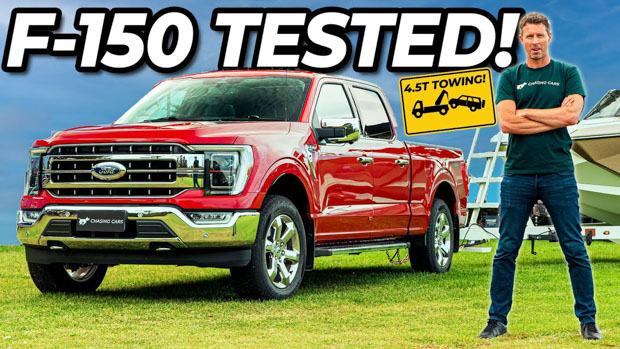
And so lands an American icon: the Ford F-150 truck, here with its steering wheel on the right side and a factory-backed five-year/unlimited-kilometre warranty. You wanted it. You got it.
Just a quick slice-and-dice job switching from left- to right-hand drive?
No chance. Ford’s local arm needed its new flagship truck to be a no-compromise, factory-good offering. “As good or better” than LHD versions was the motto of Ford Australia and F-150 re-engineering partner, Melbourne-based RMA Automotive.
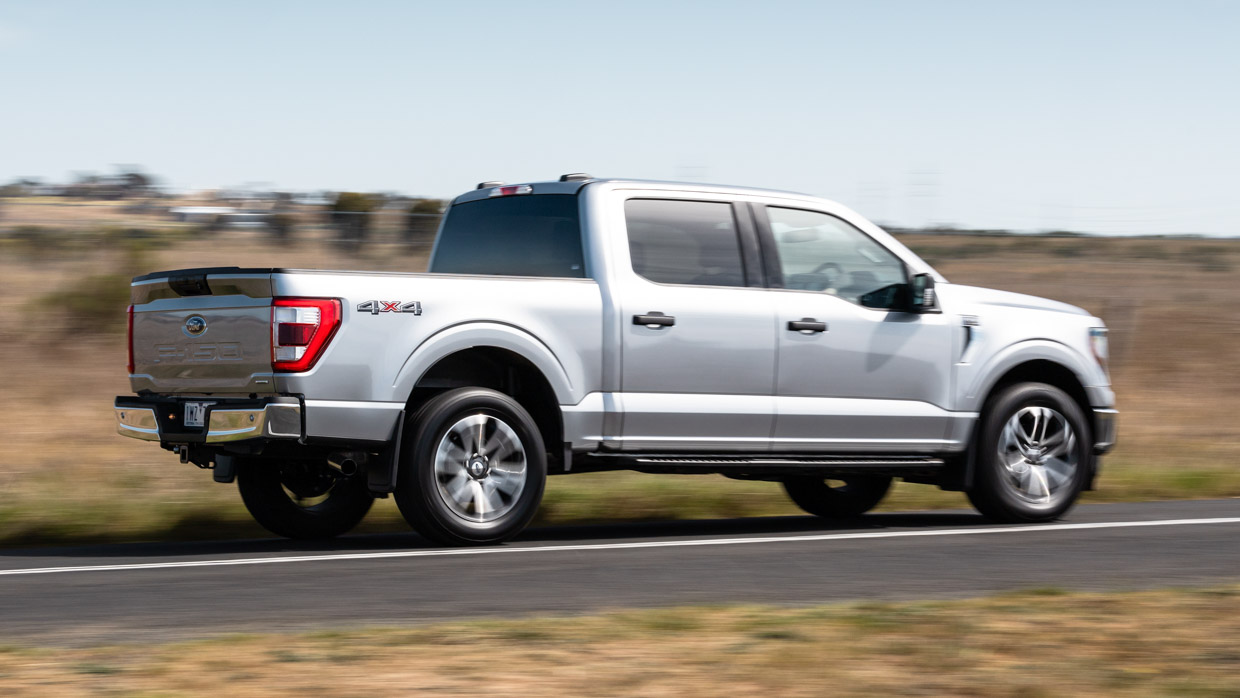
Ford’s full-size truck enters a feverish market. RAM 1500 (from $98,950 before on-road costs) sales have already surpassed 5000 this year, while the Chevrolet Silverado’s (from $121,000) nudges 2500 in 2023. Toyota’s full-size Tundra pickup truck soon joins the party.
But Ford’s F-150 is, and always has been, The Daddy. America’s best-selling vehicle for 41 years straight, and its best-selling truck for 46. Question is, have we already reached saturation point for these giant brutes, or has the Aussie love affair got many years to run?
Ford’s banking on the latter, as the investment and work involved converting F-150s locally (the world’s first RHD program for the model) has been astronomical. But the result, at first sample, has the quality hallmarks Australian buyers demand.
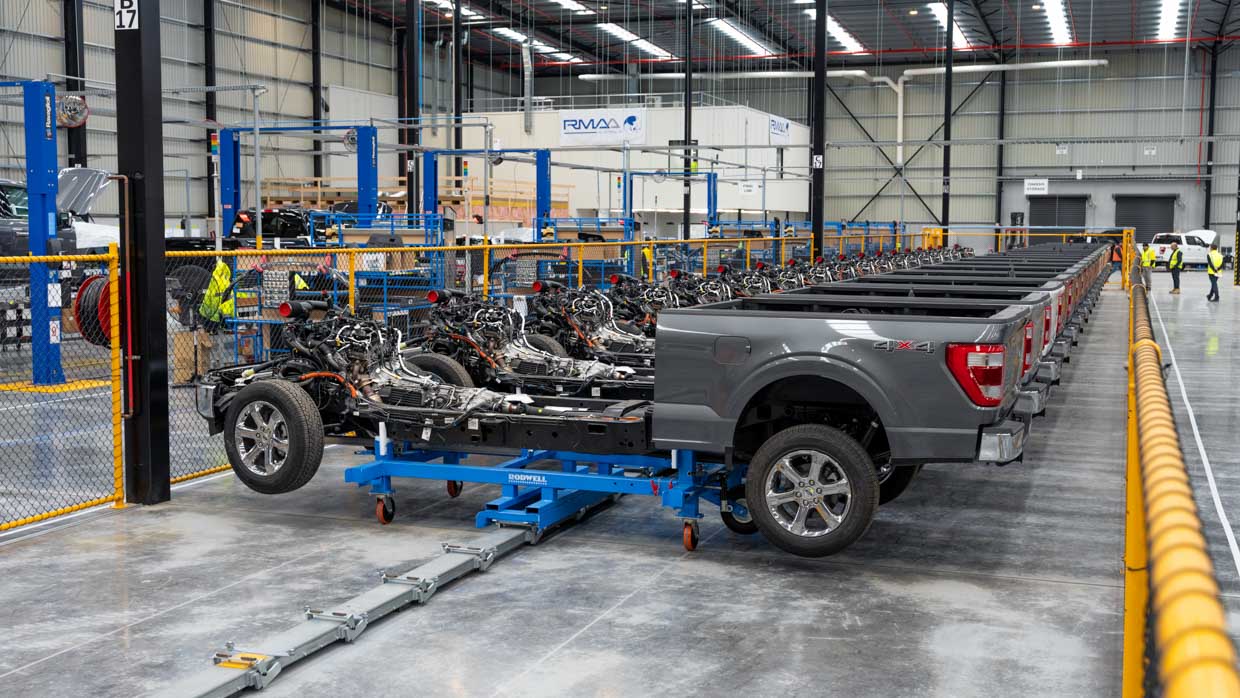
Touring RMA’s MCG-sized workshop facility, it’s confronting seeing brand new – fresh from Michigan – LHD F-150s literally taken to pieces.
Around 500 new or modified parts are required, from big-ticket items like a cast magnesium RHD cross car beam, new dash, new heating and ventilation and re-engineered lights, down to important little things like key dash buttons being on the driver’s side, the sat nav’s voice changed to Australian… even a unique 700-page owner’s manual.
The amount of parts waste and scrappage isn’t a sustainability high point – a lot of LHD kit goes straight in the bin – but if an F-150’s on your shopping list, you’re unlikely to be gluing you and your Just Stop Oil t-shirt to a city street anyway.
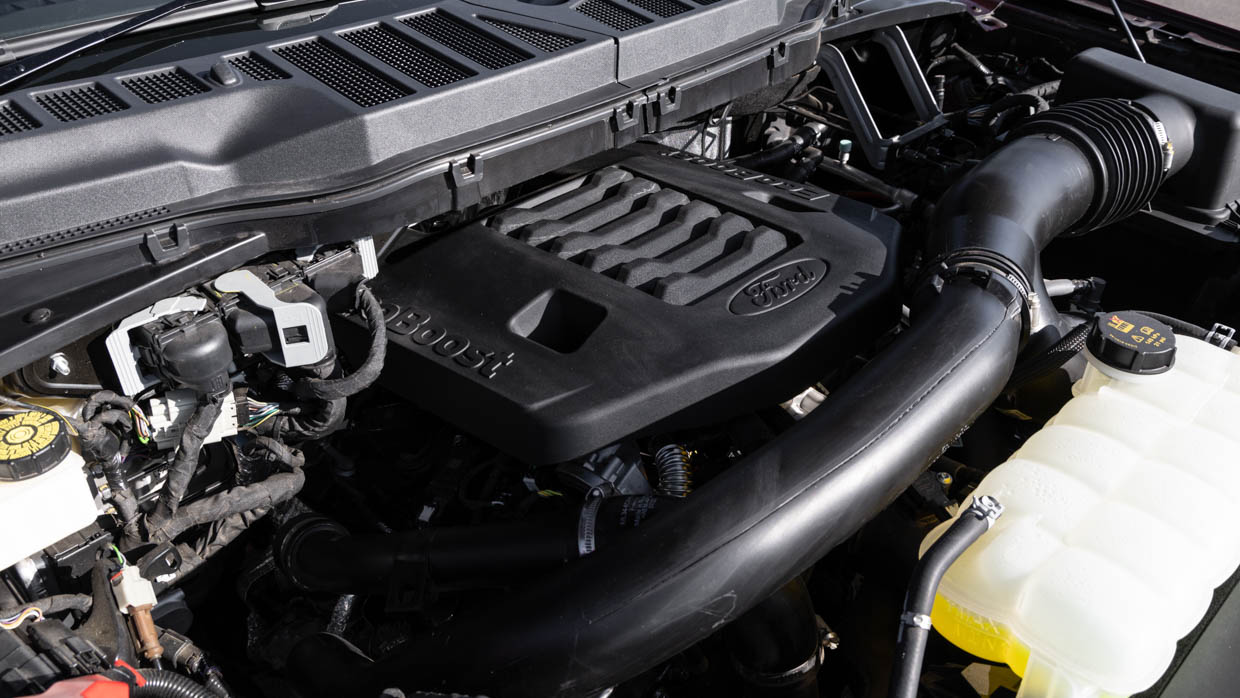
Comfort yourself knowing the Ford has a slightly less guzzling engine than its petrol V8-powered RAM and Chevy rivals. Both F-150 grades – XLT and Lariat – use Ford’s 298kW/678Nm 3.5-litre EcoBoost twin-turbo V6 petrol, mated to a 10-speed automatic transmission and claiming an average fuel economy of 12.5L/100km.
In North America a 320kW/773Nm full hybrid V6 – claiming 9.8L/100km – is offered, but there’s no word if and when this desirable hybrid version will hit Australian roads. Nor, before you ask, do we know if the full-electric Lightning or Raptor F-150s are coming either.
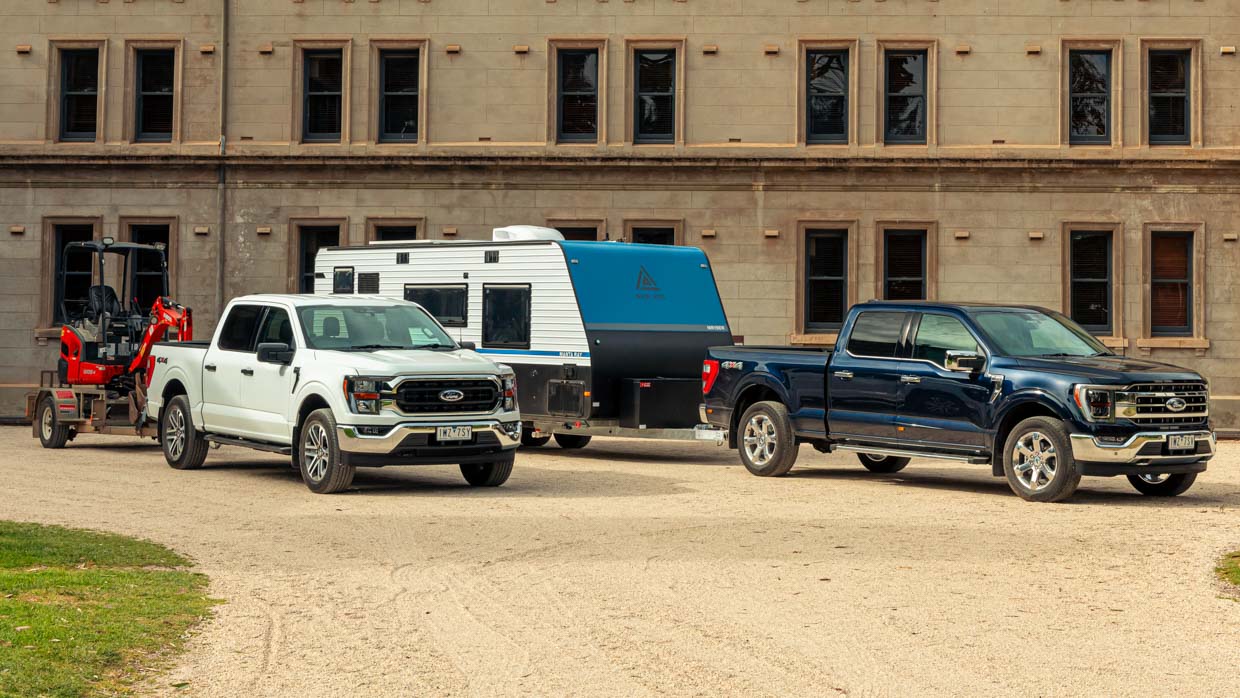
But let’s celebrate the now. The F-150 is a vehicle that knows exactly what it’s for: towing, lugging, off-road nous, cruising and cavernous interior space.
There’s 4500kg maximum towing capacity, a payload capacity up to 794kg (grade depending) low range four-wheel-drive and a 136L long range fuel tank.
The rear box is 1705mm long in short wheelbase (SWB) guise and a motorbike/quad bike-fitting 2005mm in long wheelbase (LWB), easily trumping a Ford Ranger ute’s 1547mm.
There are two trims and two sizes available. Entry level is the F-150 XLT SWB at $106,950, while the LWB version (adding 300mm to the tub, not the cabin) is $107,945.
It’s a mighty jump to the feature-packed Ford F-150 Lariat, and it’s priced accordingly. Ford asks $139,950 the Lariat SWB and $140,945 the LWB, with all prices before on-road costs.
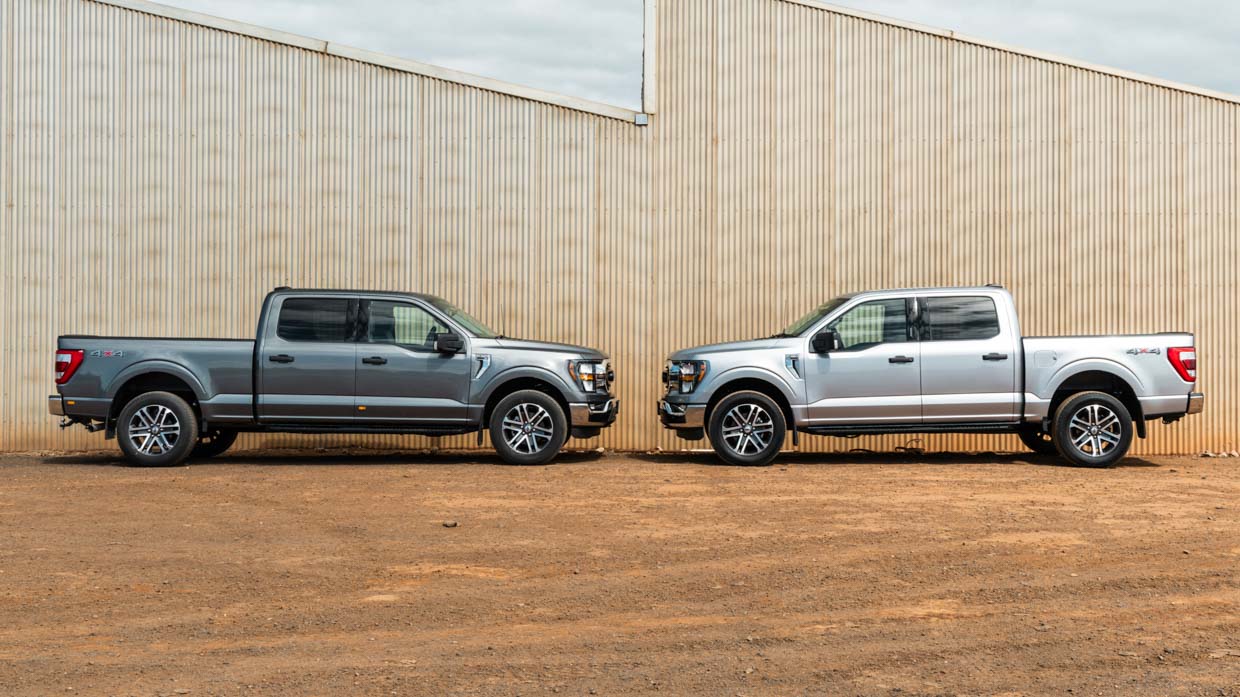
When it comes to RHD-converted vehicles, temptation’s there to check US prices for comparison.
Come on, we all do it, then grumble about our cars being ridiculously expensive.
I’ve done the sums and currency conversions and we’re actually doing alright with this F-150. Not least due to comprehensive local re-engineering costs.
A US F-150 XLT (with hinged-door Super Cab body, not Australia’s Super Crew body) with V6 EcoBoost engine, 4×4 and tow package is US$56,505 ($88,500). An F-150 Lariat with V6 EcoBoost and tow pack is US$69,395 ($109,000).
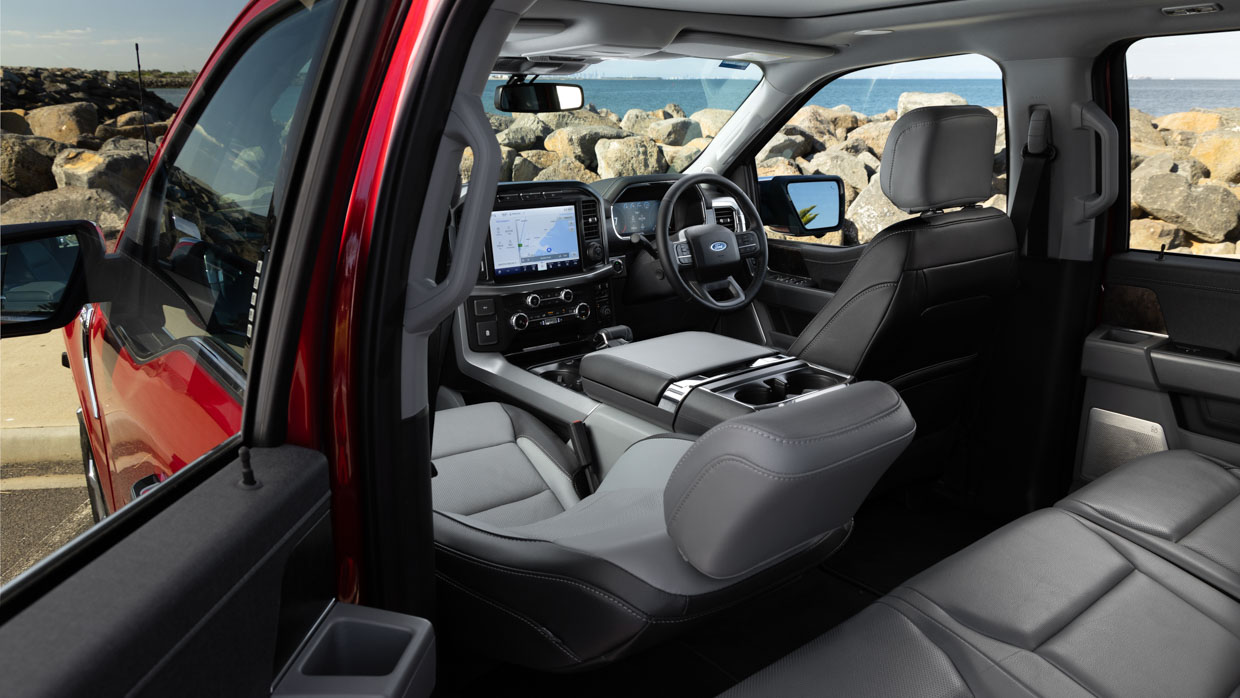
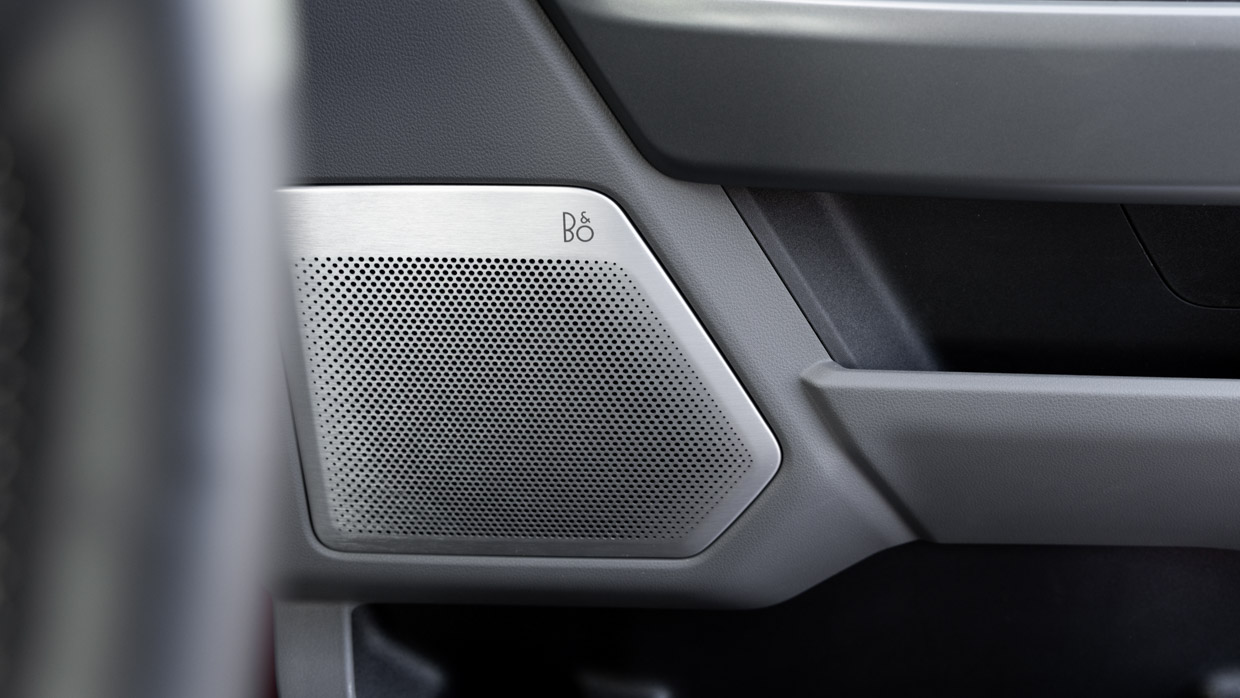
The Americans miss out on a lot of features Ford Australia include as standard, upping our value proposition. This includes 20-inch alloys, long range fuel tank, push button start, 12-way adjustable passenger seat, and the Lariat’s power tailgate, B&O sounds and 360-degree cameras.
Be aware the XLT feels quite basic by modern standards, hence its relatively good-looking price.
You’re lumbered with halogen headlights, cloth seats, a column gear shifter, non-leather wheel, no load box lighting, a non-assisted heavy tailgate and its 8.0-inch infotainment touchscreen looks tiny in such a massive cabin. No radar cruise control either isn’t ideal for long touring.
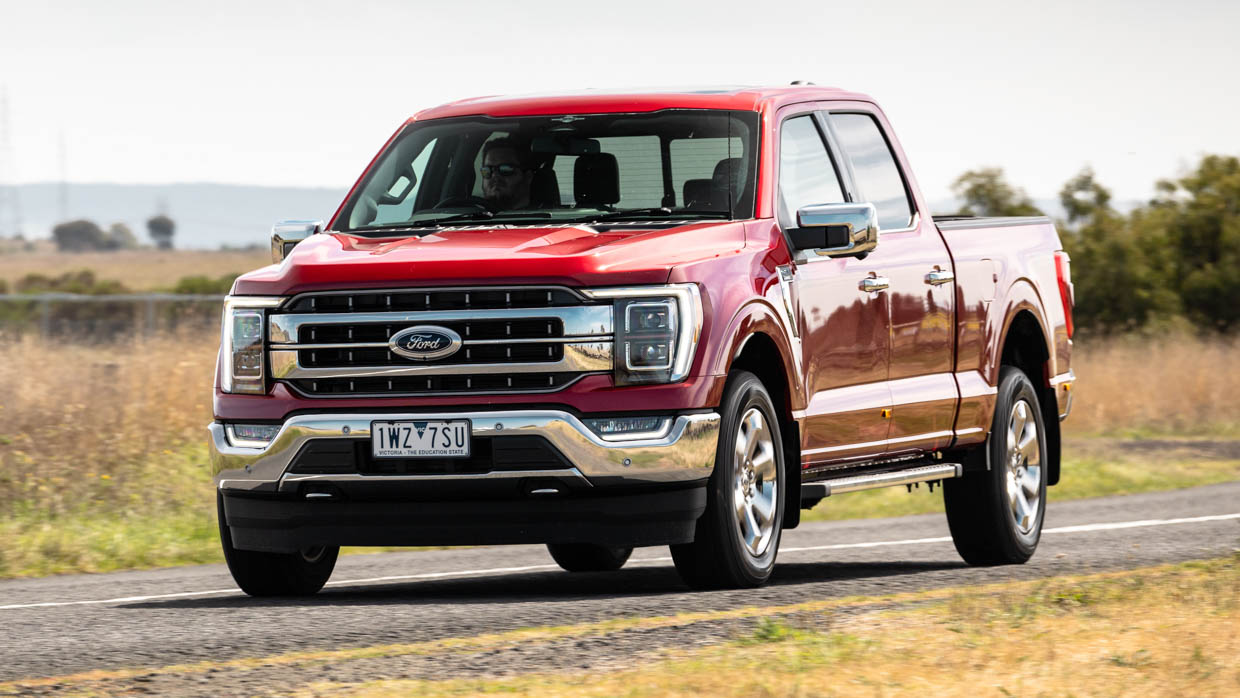
Paint is the only option. White is no cost, but you’re asked $750 for black, silver, blue, grey or red.
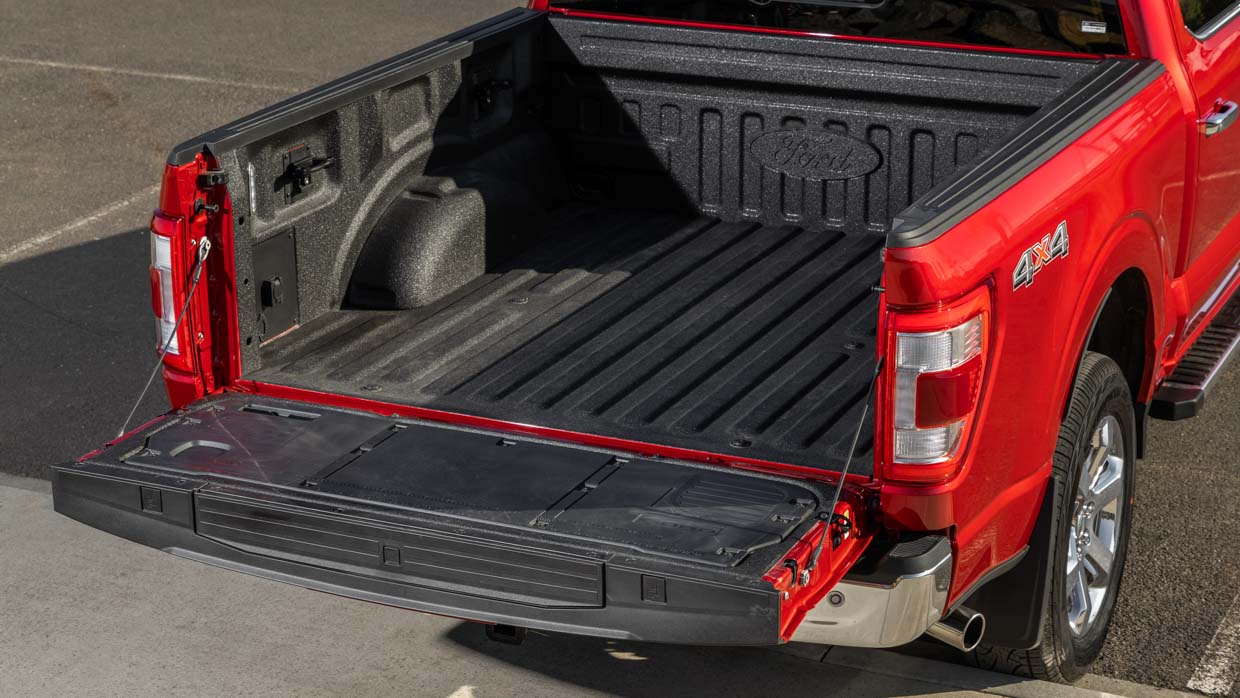
Pictured: the short-wheel-base Lariat
No head-up display or paddle shifters on either model’s a miss, as is no cargo tub cover as standard to keep contents secure. For that you must shop the accessories list – with only about half a dozen things available from launch, mostly from the US catalogue.
Be aware payload differs depending on grade and wheelbase. Underdone beside our true one-tonners, the F-150 SWB’s payload is 769kg (XLT) and 685kg (Lariat.) Move into the LWB and it improves to 794kg and 710kg respectively. These figures will tumble if you have to take into account towing downball weight.
Have you lived with a full-size American truck before? If not, take an extended test drive and pilot it around your usual stomping grounds to check you can tolerate it.
Parking spots aren’t big enough, some Australian roads are barely wide enough, the turning circle’s cargo ship-like, and all the while, the twin-turbo V6 guzzles like a very thirsty fish.
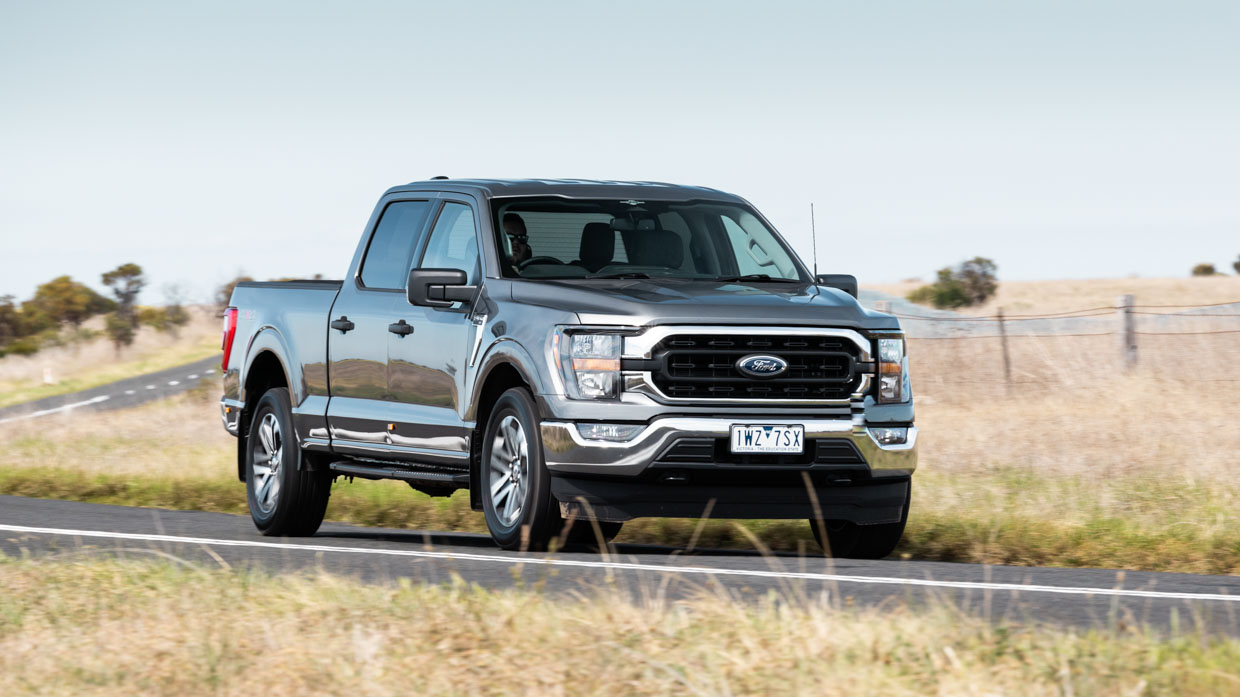
If you reckon you can cope, or if your drives are strictly rural, prepare to enjoy one of the automotive world’s most comfy and cossetting cruisers. With the 136L fuel tank you can expect to travel well over 1000km between fills… unless you’re towing. You won’t enjoy dropping $350-odd every time you brim with unleaded.
It’s simply massive. Proper King of the Road stuff. You sit impossibly high in the F-150, and visibility is superb. The overriding feeling is one of comfort and knowing there’s outright ability underneath.
Of the few negatives noted on test, the 10-speed automatic transmission had moments of mild clunkiness at low speed, but once moving it’s a seamless, rapidly cog-swapping joy. Even so, paddle shifters would be a welcome inclusion.
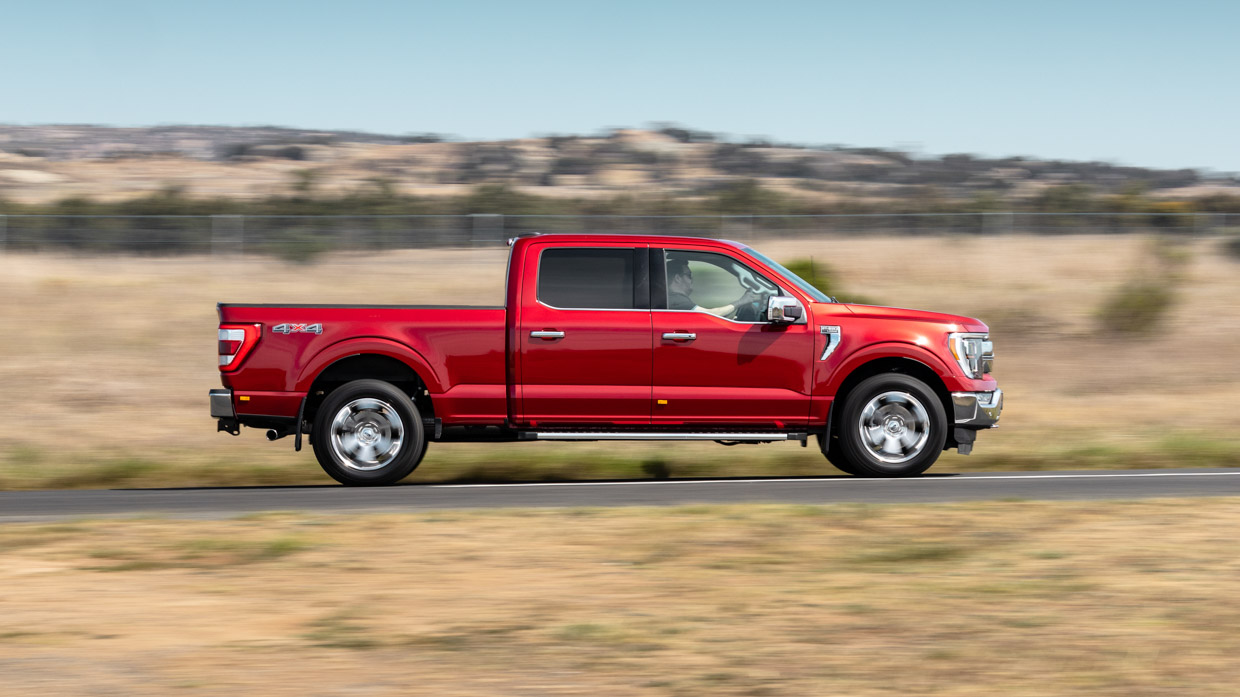
With no load in the tub or anything under tow, it suffers much like our one-tonne utes: a bit of a jittery ride and then marked bouncing – especially if sat in the back – when you hit a big road bump.
Otherwise, it’s damn plush. On good roads it glides along, and on a smooth highway it’s almost limo-like. Imperfections are laughed at; insulation brings peace to the ears and the V6 petrol barely makes a peep.
Which you may grumble about, as you’re in a giant US truck ’n all. The V6 twin-turbo petrol makes a decent note if you floor it and windows are down, but otherwise you’d barely know it was there. I missed the V8 rumble of the Chevy and Ram opposition. A bent eight just feels, well, The Right Stuff.
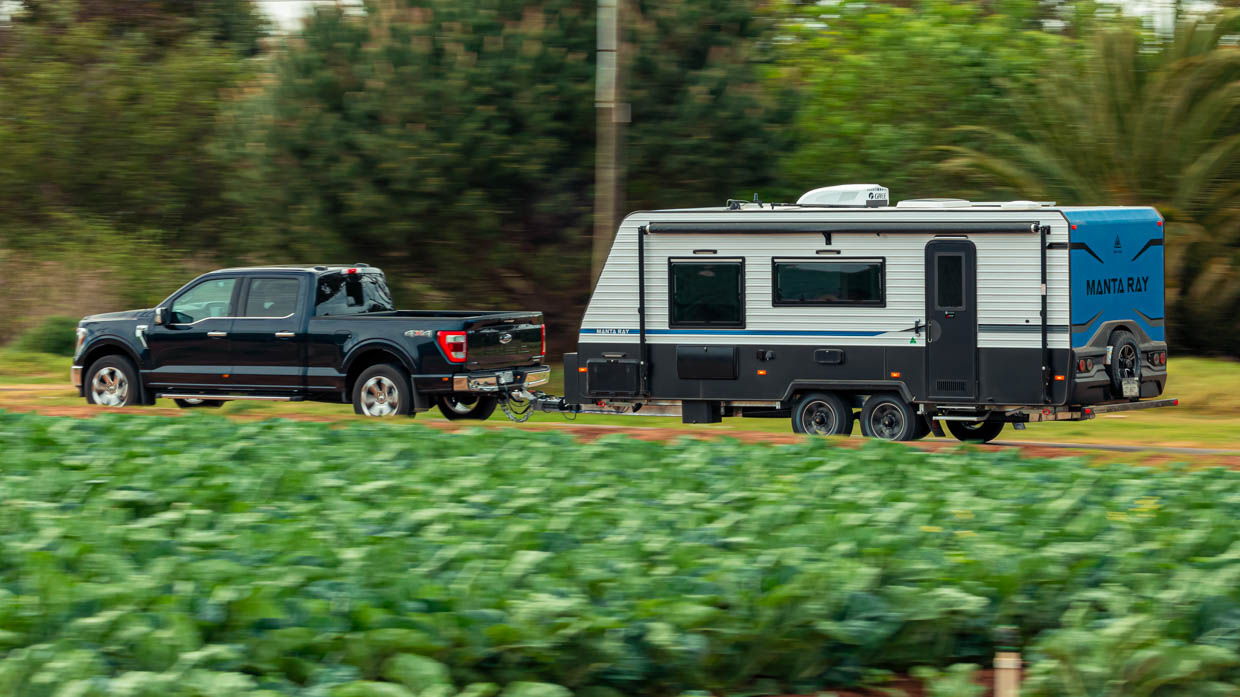
But Ford’s twin-turbo EcoBoost V6 has them both licked on the torque front, and good grief this F-150 behemoth can shift, despite its hulking 2500kg unladen kerb weight.
As the Americans say, the Ford F-150 has no problems “getting out of the hole,” with an unofficial 0-100kmh time around five seconds.
Yep, faster than your twin-turbo V6 Ford Ranger Raptor. It seriously shifts, belying its size and mass. But it’s not outright fun in the way it would be in, say, your Ford Mustang. It’s more a blunt instrument than anything displaying finesse.

Ford’s local division described the F-150’s drive as “not like a truck,” praising its “agility and nimbleness.”
Which is of course utter nonsense. What you’ve got here is a 2.5-tonne truck, and it very much drives like one. It’s unwieldy, high riding and has a wheelbase with its own time zone. On tight roads it’s not great for your nerves.
That said, it handles okay for such a whopper, and rewards smooth, steady driving inputs. But you must exercise caution before trying any hard cornering, especially in the wet.
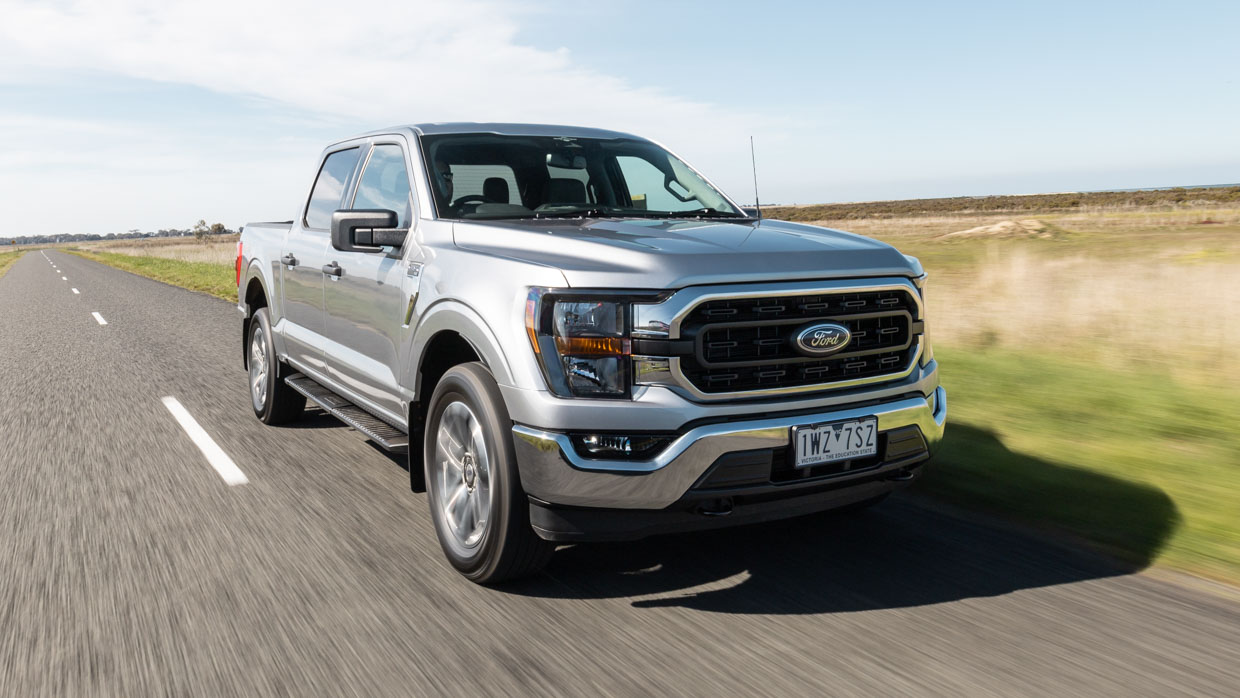
The steering rack’s a modified Ranger Raptor RHD unit, given a new steering calibration for our market. It doesn’t feel as sharp and almost race truck-like as a Raptor, but errs more on the side of easy and light. Really, it’s perfectly befitting the F-150’s intended use.
Our launch test had us towing a 3000kg caravan, and the ride quality – as you’d expect – was more planted. The V6 made short work of hauling the mass on tow, illustrating why these full-size US trucks are so coveted by heavy van pullers. But caution was still needed. We were too eager on the throttle and the F-150 started spinning wheels.
No opportunity to go off-roading sadly, but it proved a simple clunk-free task to sling into low range 4×4, and there’s confidence knowing all F-150 models come with electronic locking rear differentials.
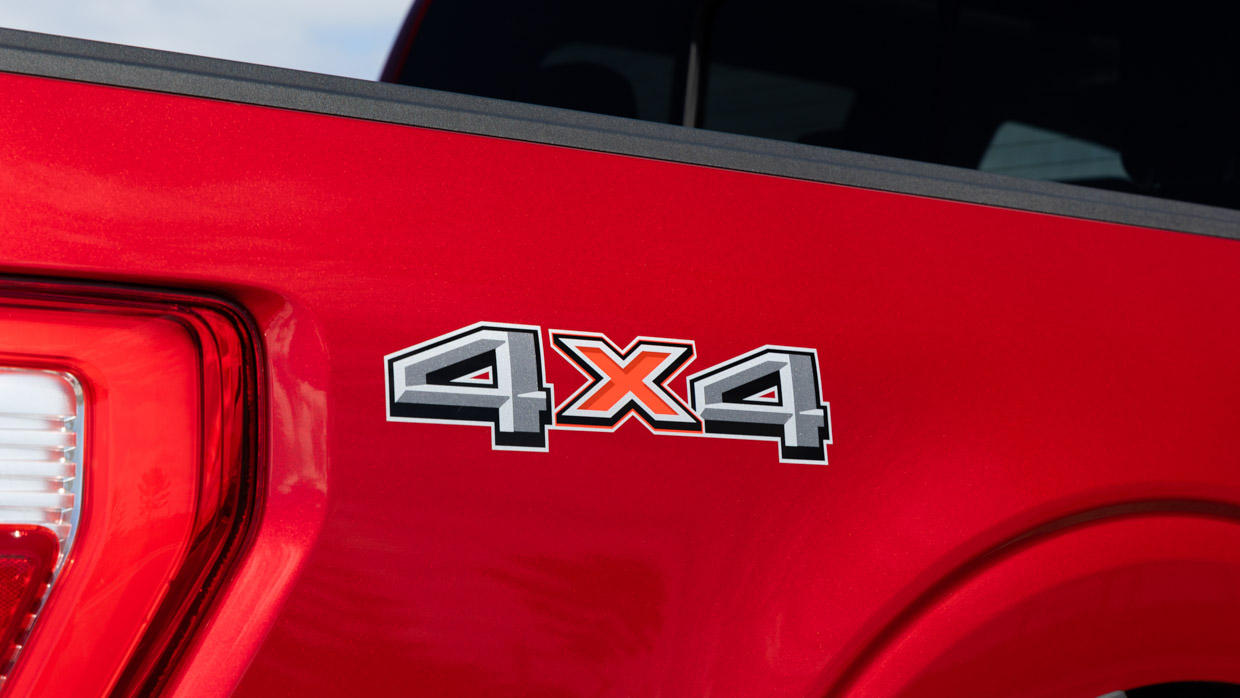
Ground clearance is 239mm the SWB, and 225mm the LWB. Approach, departure and ramp breakover angles are 24.3/25.3/20.0 the SWB, and 24.0/26.3/19.0 the LWB.
Be aware the XLT is a part-time 4×4, running in RWD mode most of the time unless you shift on-the-fly to four-wheel-drive when you leave sealed roads. Like the Ranger V6, the Lariat is full-time four-wheel-drive.
Think hangar-like space. You climb up and into the vastness of the F-150’s cabin, and, for the XLT at least, it feels very workmanlike. The Lariat may cost an extra $33,000, but it’s the choice to rival modern SUV ambience. Ford Australia expects the Lariat Big Dog to make up 65 per cent of sales.
The XLT’s cloth seats feel hard-wearing, comfy and supportive, but miss any element of luxury. The dash display with traditional analogue gauges bookend an eight-inch information screen, while the small-looking 8.0-inch infotainment and dash panel feel basic in the Lariat’s company.
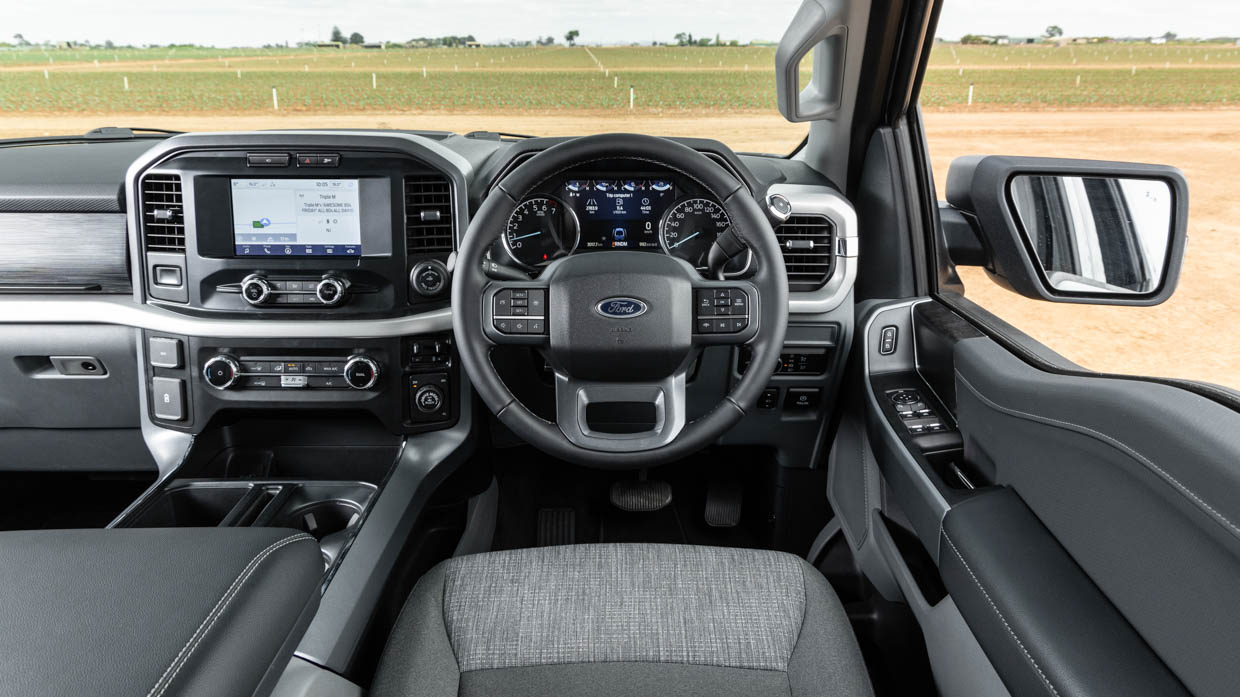
Hard plastics abound, but at least armrests are soft and spongy for lounging back on your lap of Australia. Credit for fitting power adjustable foot pedals – a rare treat to help you find an ideal driving position.
Doors have numerous segmented areas for drinks bottles and gear, while the centre console and under the armrest – think Esky-sized – give you space options for hosting a giant buffet up front. They even give you a handy table. It unfolds from the centre console, giving space enough to work on a laptop or lay out your lunch.
It’s made easy by the XLT’s column gear shifter, which feels incredibly old school and pleasingly trucker-like at the same time. The F-150 Lariat has the more expected central shifter, which has been re-engineered for RHD use. Push a button and it electrically folds away, allowing the little table to be used. Very cool.
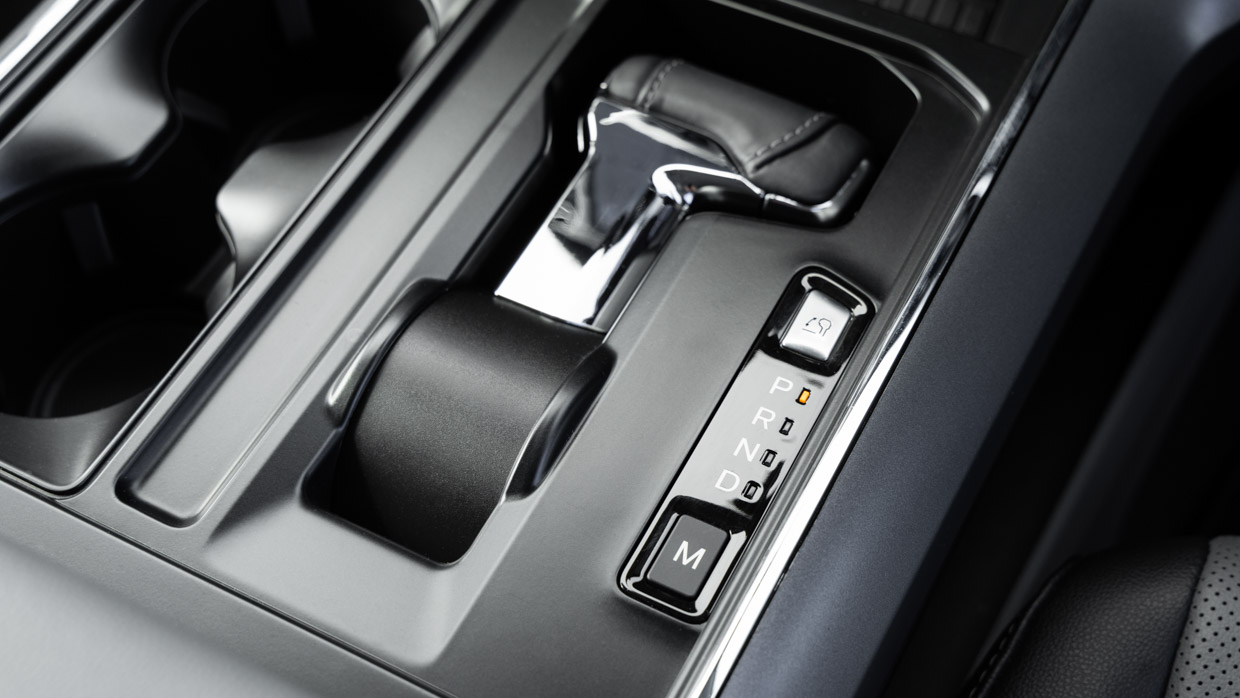
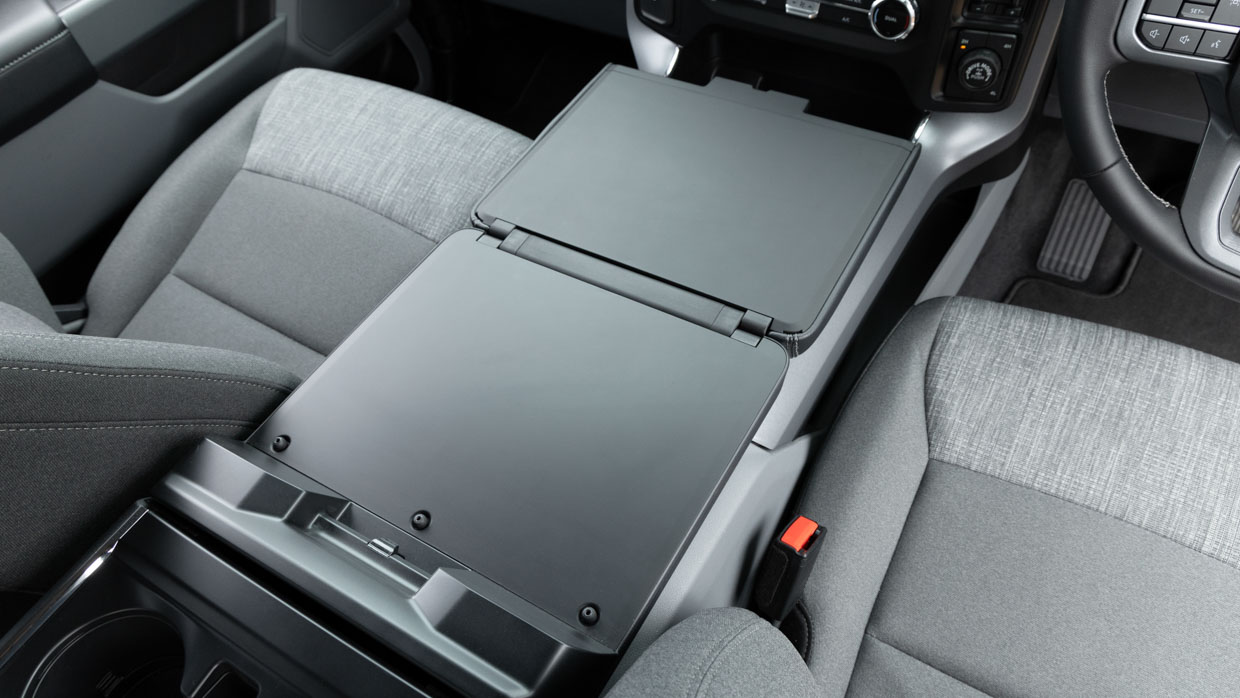
Ford’s Sync 4 communication and infotainment is, in its current generation, one of the best operating systems I’ve used. Quite quick and very intuitive, plus the voice command hit rate is better than most. Naturally, there’s CarPlay and Android Auto – which 99 per cent of people will use – but you still need a cable to connect.
Rear travellers have acreage. Head and leg room are quite exceptional – if seatbelts weren’t a thing the kids could play hide and seek in the back. Rear seats get USBs, air vents and padded door armrests, but XLTs miss out on a centre armrest.
Despite the size, rear seat backs are upright and firm. I’d have preferred losing a few inches of leg room to have these rears recline.
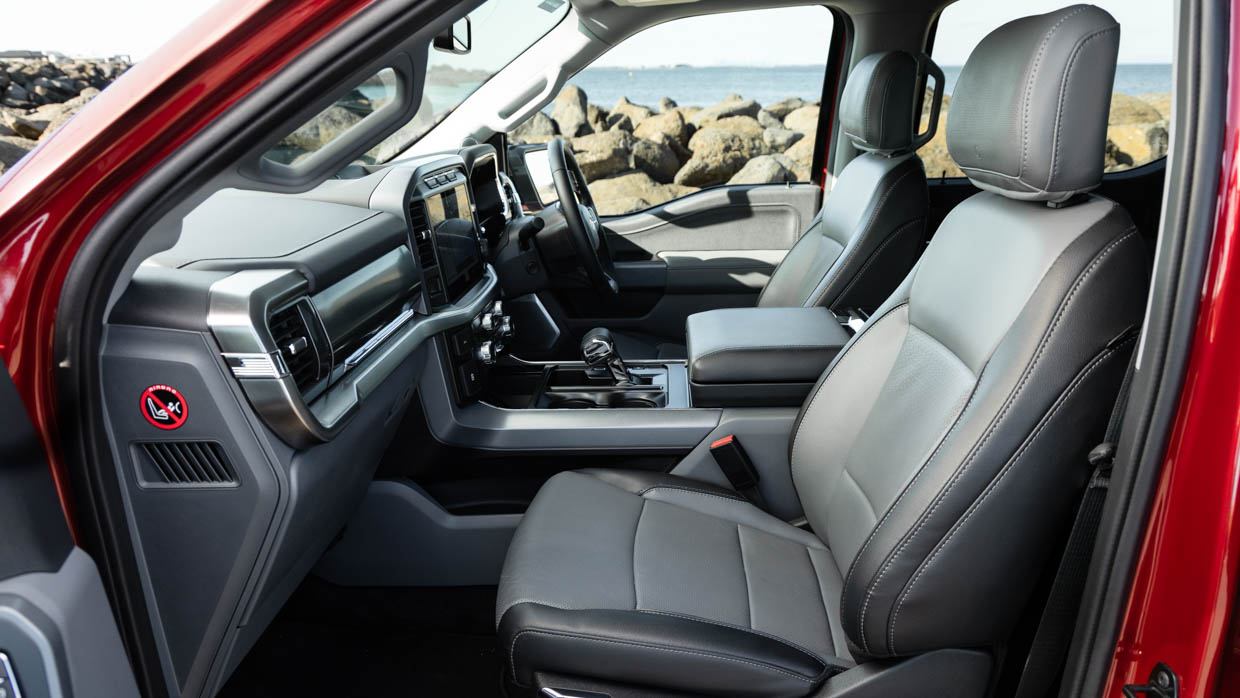
Plastic door lock buttons look cheap and from another era, but at least there’s excellent room under the back seats to store kit and a tow bar. The Lariat has proper box storage here, looking like it’d house a few rifles or cricket bats, depending on your hobby.
The Lariat’s leather trim’s nothing too fancy, erring on robustness rather than outright luxurious. Hard plastics remain, but the larger screens – infotainment and driver display – make a huge difference to modernising the aesthetic.
And kudos where it’s due, the re-engineering has superbly relocated audio and navigation buttons to suit RHD drivers.
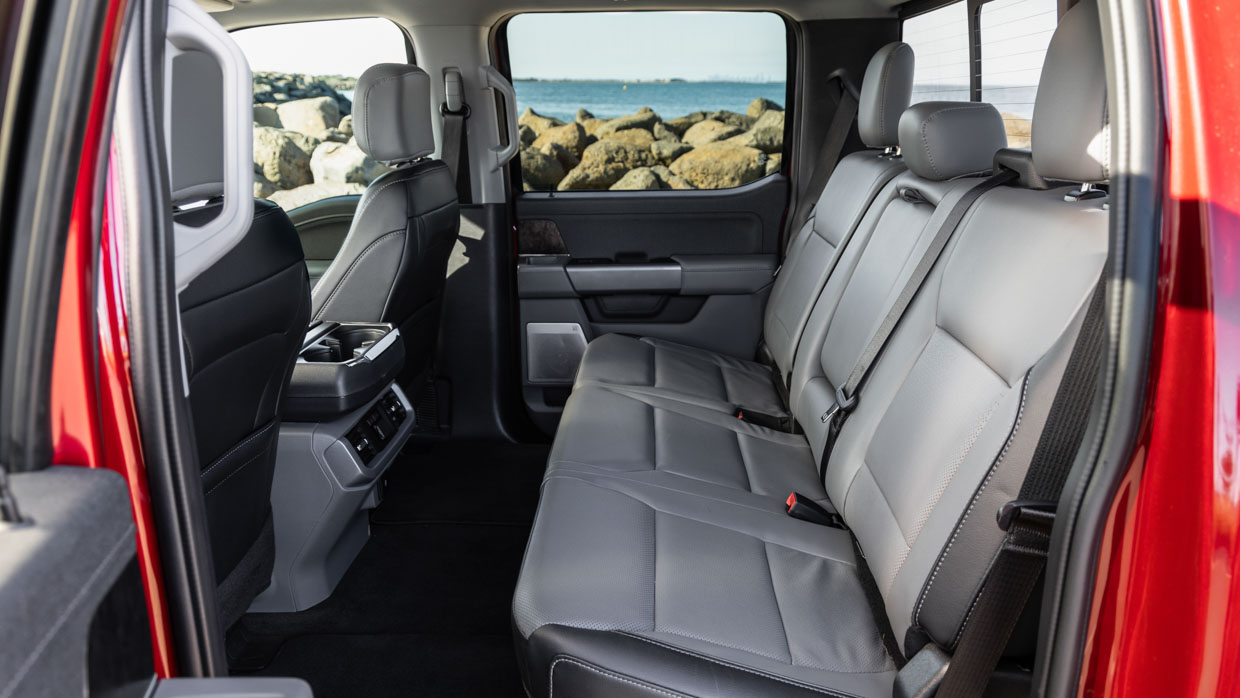
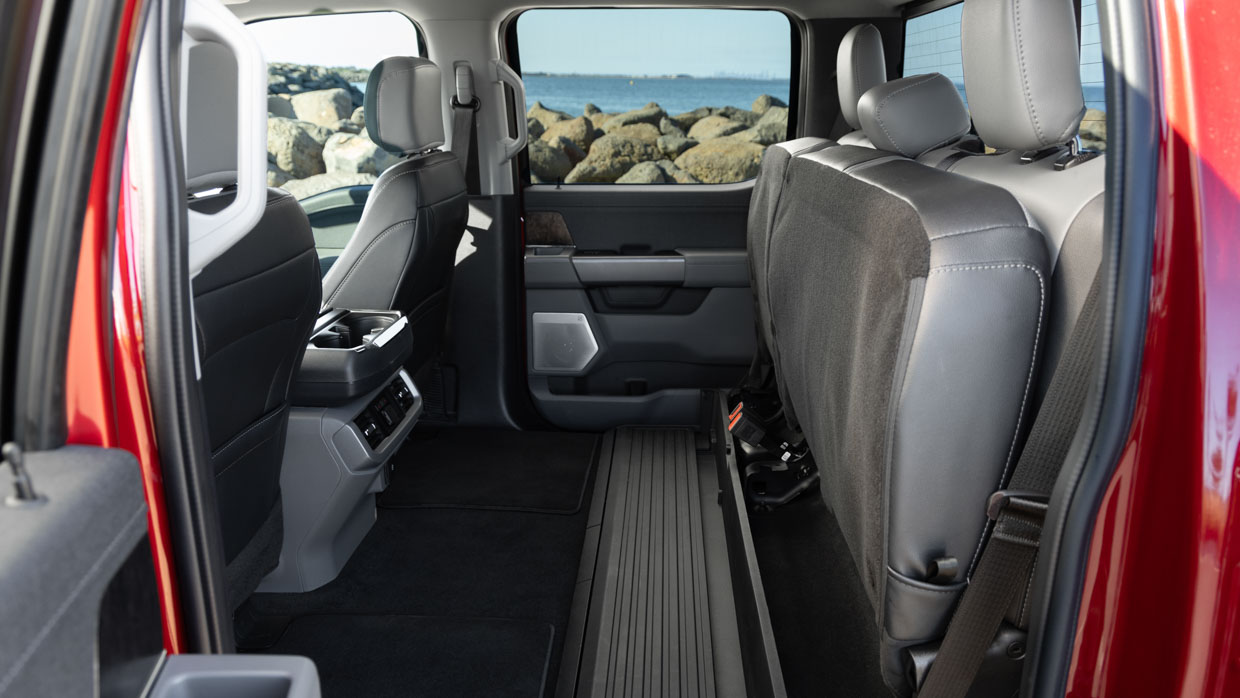
Memory seats and pumping B&O sounds spoil you, and overall ambience – especially for rear passengers – is really boosted with the Lariat’s glass roof.
Both XLT and Lariat get Ford’s Pro-Trailer Back-Up Assist. Once you’ve pre-inputted a trailer or van’s dimensions, you can simply watch the central screen’s plethora of camera angles and rotate a dash dial in the direction you want to trailer to go.
It then turns the steering wheel for you. For those who’ve never cracked which way to steer when reversing a trailer, it’s a godsend. But need practice first.
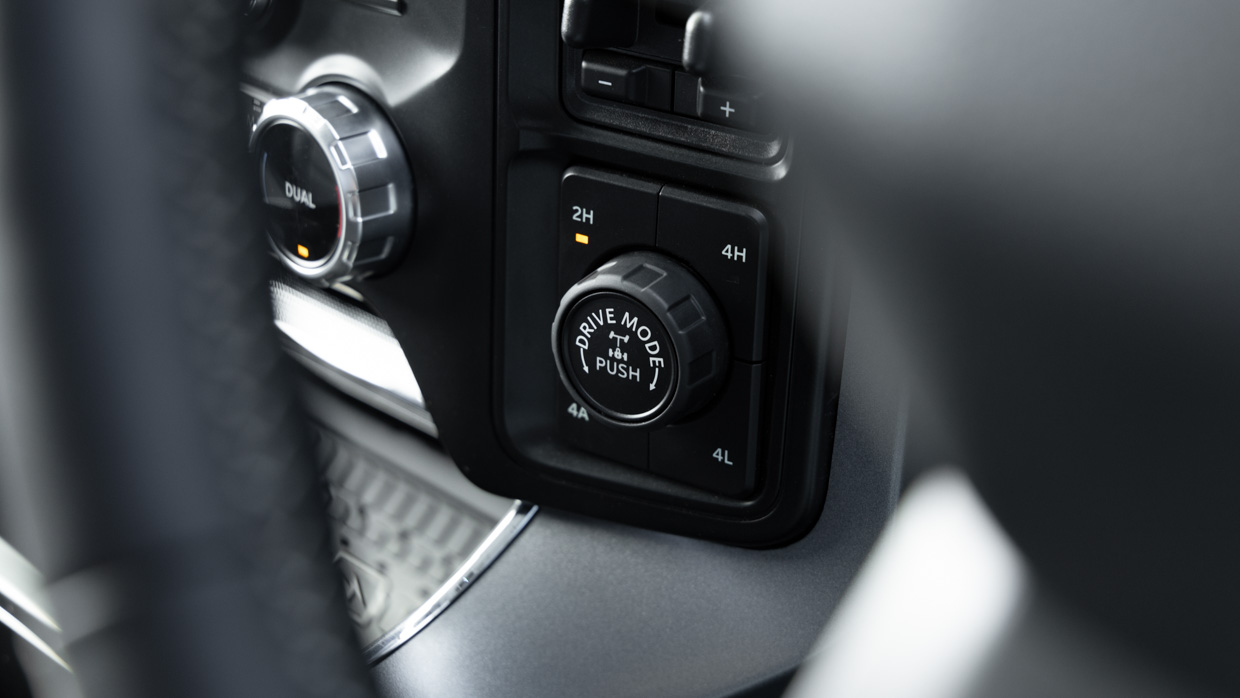
FordPass Connect allows a trailer light check; and remote starting, heating and cooling the cabin to the last setting.
Sorry to sound soft, but the XLT’s tailgate suddenly feels very heavy and cumbersome once you’ve got used to the Lariat. Its tailgate auto raises and drops with a pad squeeze. That’s really living.
Oh, and you know the Ford Ranger’s handy bumper step to easily get better access to the tub? The F-150 dearly needs similar. You’ve got to clamber into the tub – and it’s a big clamber – to reach into the cargo compartment.
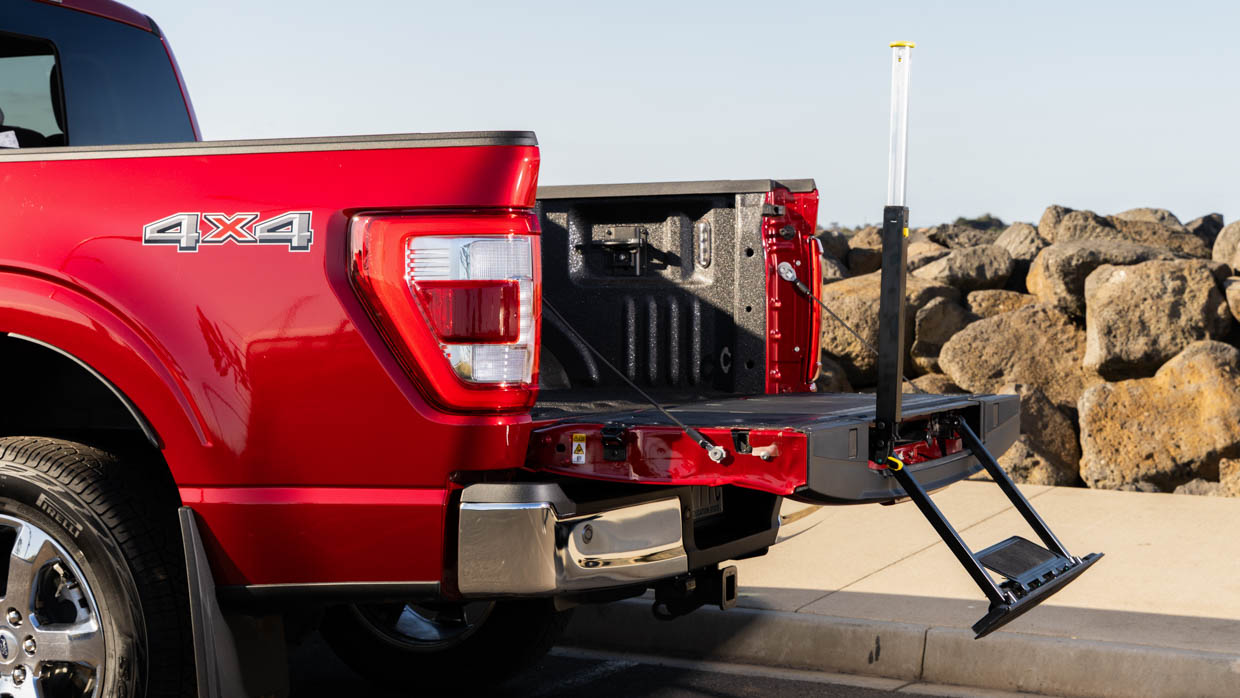
What’s not tangible until you actually sit in this re-engineered F-150 is how very, very good the conversion is. I looked for any sign of out of line fittings, problems, compromises, rattles or squeaks.
Nothing to be found. They aimed for factory good or better, and it’s been achieved.
ANCAP hasn’t crash tested the F-150. Australian F-150 models have been comprehensively remanufactured so are different vehicles to the LHD US-sold F-150s.
Regardless, it’s worth noting ANCAP’s US equivalent, the NHTSA, gave the 2023 F-150 a maximum 5 Star overall safety rating.
For frontal crash and side crash it scored five Stars, but only four Stars for rollover resistance. The NHTSA said the F-150’s ‘Rollover Risk’ was 19.10 percent. For context, rival Chevy Silverado 1500 scored a worse 19.80 percent and the RAM 1500 21.90 percent.
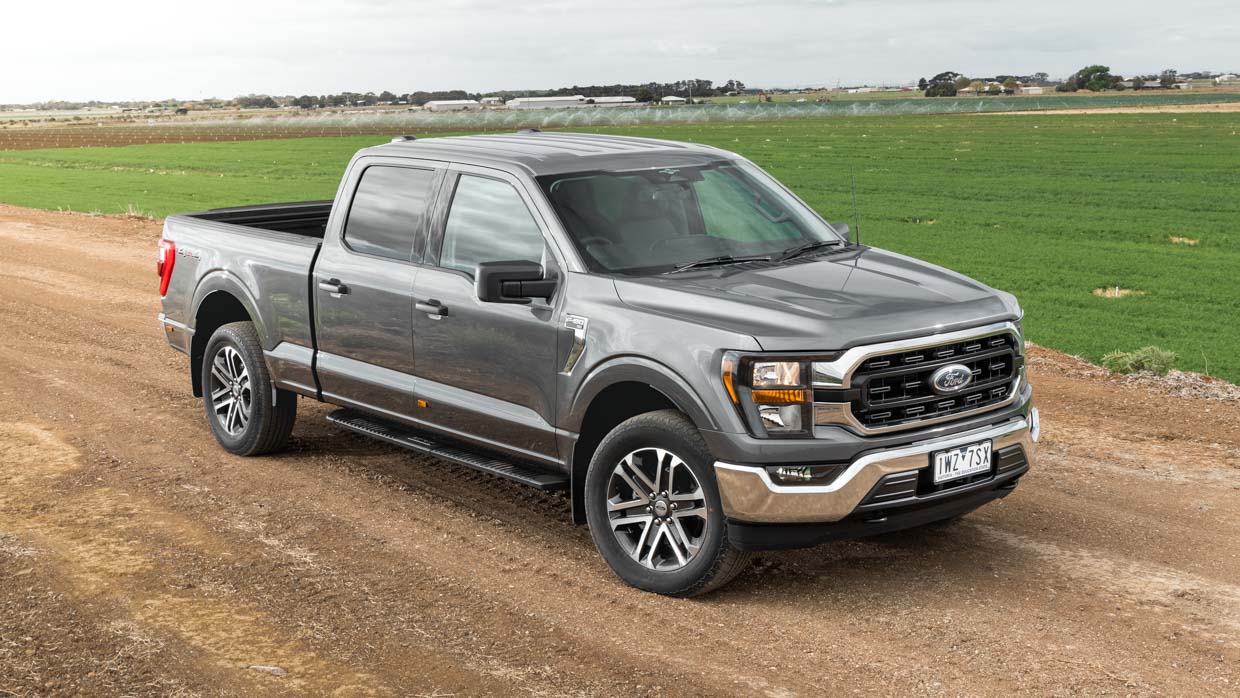
Interestingly, the smaller Ford Ranger’s rollover risk is even worse at 25.60 percent. A proper car, like the Ford Mustang, has a rollover risk of 9.30 percent.
The entry-level F-150 XLT includes what I reckon are the key safety features drivers want: automatic emergency braking (AEB), blind spot monitoring and rear cross traffic alert. The latter is indispensable when backing out of spaces in this giant.
But the XLT excludes some key kit. No adaptive cruise control’s a huge miss for those long highway drives, while no front sensors nor 360-degree camera makes urban parking and manoeuvring a sweaty chore. Thankfully, all come with the Lariat grade.
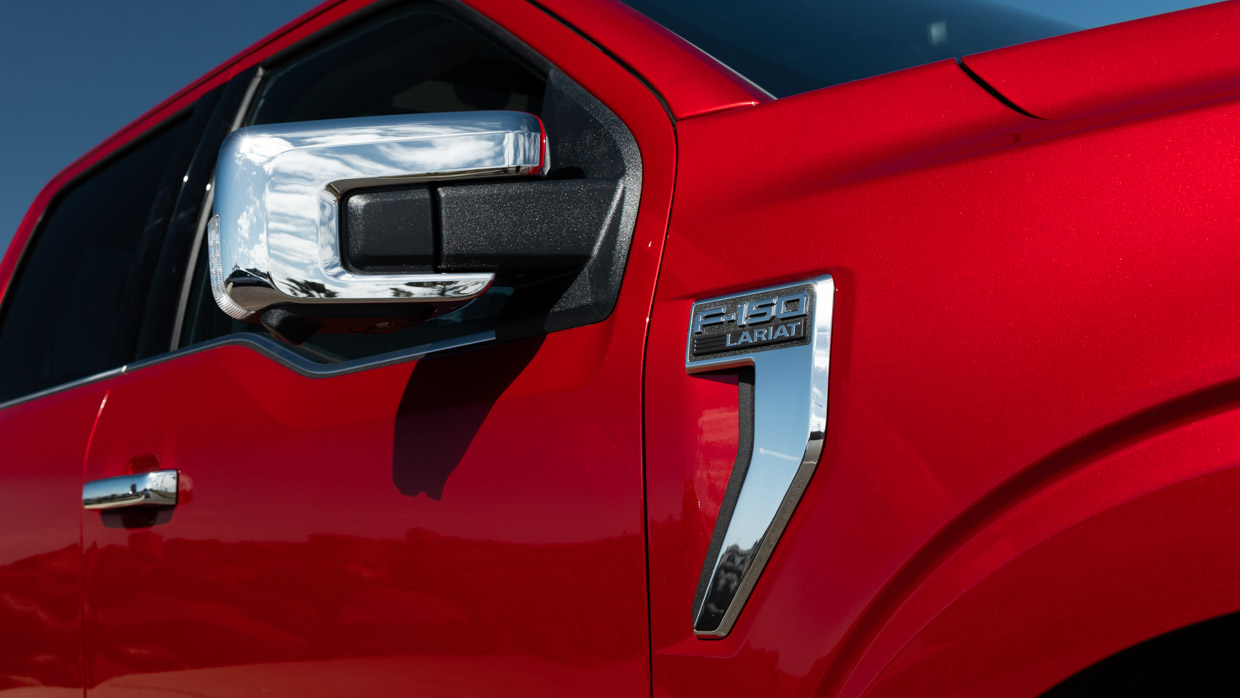
Big rig, big running costs? You may be in for a pleasant surprise.
The F-150 requires servicing every 15,000km/annually, with the first five totalling a reasonable $2076. A Ford Ranger V6 diesel, you see, is a much chunkier $2590 for the five years/75,000km.
Warranty at five-years/unlimited kms is average for the industry, and matches everything else in Ford’s range. Positive of it being a factory-backed conversion is the RHD F-150 is fully recognised by Ford dealers as one of its own. It was never that way when third parties were doing RHD conversions.
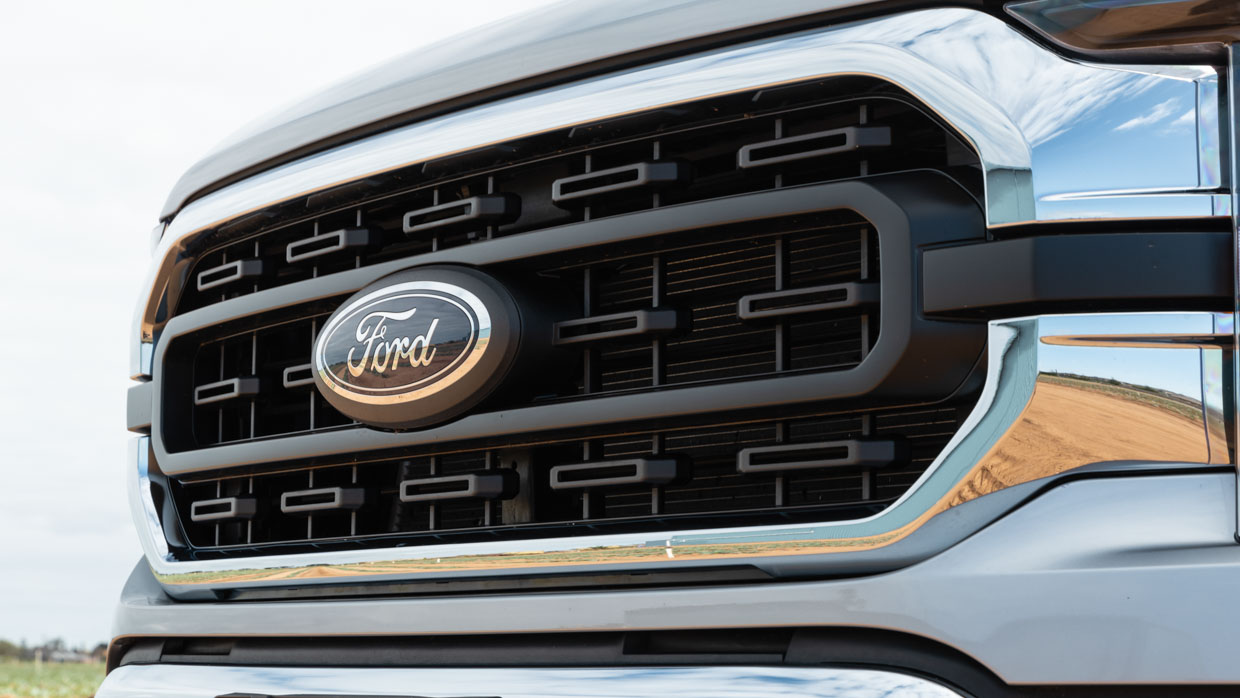
Ford Australia has also only released combined fuel economy figures – 12.5L/100km – but not for highway use or in town.
Given the 136-litre tank, the stated driving range works out to a fairly huge range of around 1088km, and it would no doubt go further in real world highway conditions on a classic Aussie road trip.
Our test had us in single digits when cruising (unladen), but the limited stop/start town driving we did finished with a number starting with ‘2’. For both your wallet and sanity, seriously consider something else if most of your F-150 trips will be urban.
RAM’s advertising may say it “Eats the others for breakfast,” but there’s every chance this new F-150 will dine out on its rivals – RAM 1500s included – for lunch, dinner and probably dessert as well.
And it does so with a torque-packed twin-turbo V6 petrol, not a V8. Nostalgists may bemoan this, but it’s the correct engine for 2023: versatile, gutsy and reasonably economical. The only thing you miss is the sound.
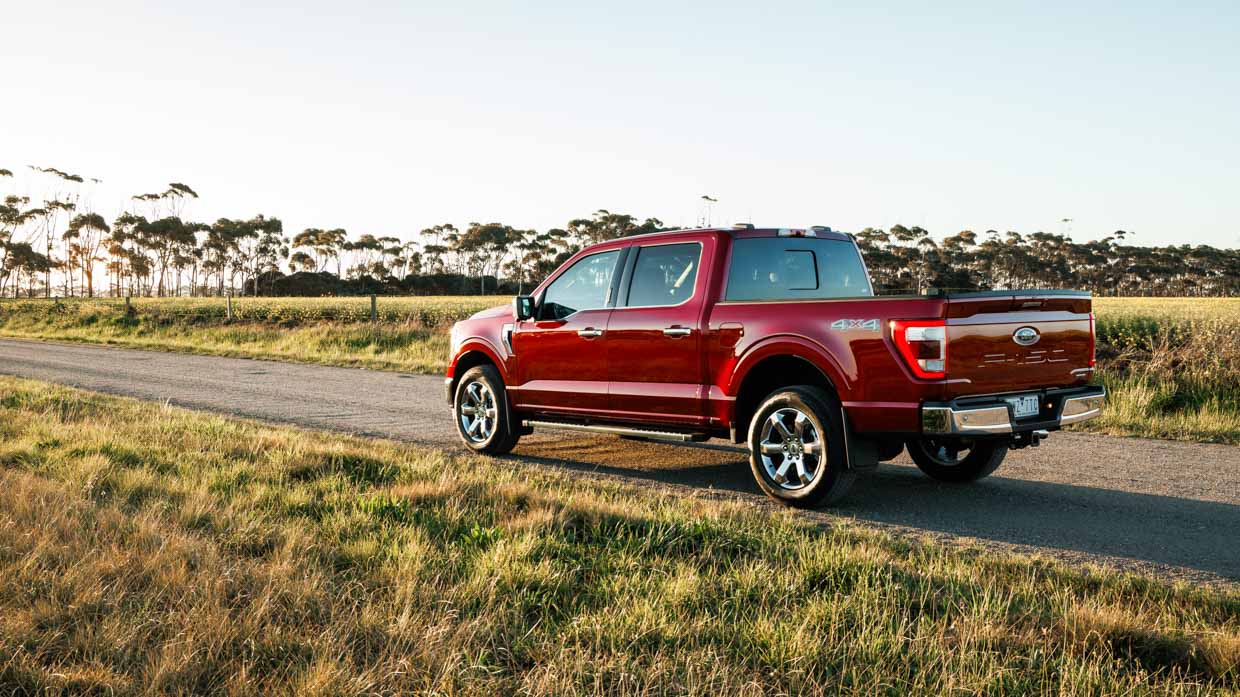
Buyers will love the F-150’s space, versatility, towing ability, very good general ride quality and remarkable quality of the RHD re-engineering. Ford’s local arm has made sure the latter was a priority, and it’s succeeded.
A giant ‘look at me’ toy for all your recreational fantasies. The XLT looks excellent value, but for a proper indulgent experience it must be the Lariat.
The F-150’s not perfect, and driving a full-sized US truck means compromises, but you can all but guarantee Ford won’t be able to build (or rebuild) these things quickly enough.
About Chasing cars
Chasing Cars reviews are 100% independent.
Because we are powered by Budget Direct Insurance, we don’t receive advertising or sales revenue from car manufacturers.
We’re truly independent – giving you Australia’s best car reviews.
The estimate provided does not take into account your personal circumstances but is intended to give a general indication of the cost of insurance, in order to obtain a complete quote, please visit www.budgetdirect.com.au. Estimate includes 15%^ online discount.
^Conditions Apply
Budget Direct Insurance arranged by Auto & General Services Pty Ltd ACN 003 617 909(AGS) AFSL 241 411, for and on behalf of the insurer, Auto & General Insurance Company Limited(ABN 42 111 586 353, AFSL 285 571).Because we don’t know your financial needs, we can’t advise you if this insurance will suit you. You should consider your needs and the Product Disclosure Statement before making a decision to buy insurance. Terms and conditions apply.
Indicative quote based on assumptions including postcode , 40 year old male with no offences, licence suspensions or claims in the last 5 years, a NCD Rating 1 and no younger drivers listed. White car, driven up to 10,000kms a year, unfinanced, with no modifications, factory options and/or non-standard accessories, private use only and garaged at night.
^Online Discounts Terms & Conditions
1. Discounts apply to the premium paid for a new Budget Direct Gold Comprehensive Car Insurance, Third Party Property Only or Third Party Property, Fire & Theft Insurance policy initiated online on or after 29 March 2017. Discounts do not apply to optional Roadside Assistance.
2. Discounts do not apply to any renewal offer of insurance.
3. Discounts only apply to the insurance portion of the premium. Discounts are applied before government charges, taxes, levies and fees, including instalment processing fees (as applicable). The full extent of discounts may therefore be impacted.
4. We reserve the right to change the offer without notice.